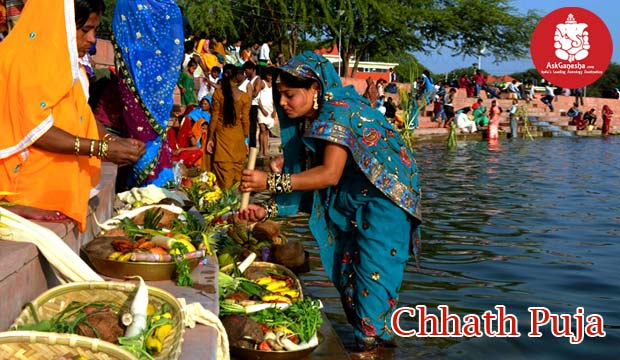Chhath Puja

Chhath Puja Date & Mahurat
The upcoming schedule for Chhath Puja is on dates: 27 October, 2025
About Chhath Puja
Chhath Puja is also known as Dala Puja. It is a Hindu festival popularly celebrated in the Northern and Eastern Indian states of Bihar and Jharkhand and even Nepal. The word 'Chhath' means 'sixth'. This day is celebrated on the 6th day or 'Shasthi' of the lunar fortnight of Kartik (October - November) in the Hindu calendar – six days after Diwali, the festival of lights.
Legends of Chhath Puja
It is believed that during the times of the Mahabharata, Chhath Puja was performed by Draupdi, the wife of Pandava Kings. Once during the long exile from their kingdom, thousands of wandering hermits visited their hut and being devout Hindus, the Pandavas were obliged to feed the monks. But Pandavas were incapable to offer food to so many hungry hermits. Seeking a speedy solution, Draupadi approached Saint Dhaumya, who advised her to worship Surya and observe the rituals of the Chhath for prosperity and abundance.
How Chhath Puja is celebrated?
Chhath Puja goes on for four days. It is a joyous and colourful form of festival as people on this day get dressed up in their best clothes and gather by rivers and other water bodies to celebrate Chhath. Devotees take a holy dip at dawn before preparing the ritual offerings or 'prasad,' which mainly comprising 'Thekua,' a hard and crude but tasty wheat-based cake usually cooked on traditional earthen ovens called 'chulhas.'
Rituals and Traditions of Chhath Puja
It is said that worshipers of the Chhath Puja take holy bath and follows a period of self-discipline and become separate for 4 days from the main family. Throughout the time, he is believed as the pure strength and sleep on the floor having single blanket. There is a belief that once a family begins Chhatt Puja, he has to perform it every year as well as pass it to his next generations and it can only be skipped when there is a death of any person in the family that year.
Devotees offer prayers and prasad to Sun at the Chhath such as sweets, Kheer, Thekua and fruits included in a small bamboo tokari. Salt, onions or garlic should not be used with maintained purity.
It is a four days festival which includes
On the very first day, devotees take holy bath early in the morning in the holy water of Ganga. They bring some water to their home to prepare the offerings. Home should be cleaned at this day. People take only one meal a day known as kaddu-bhat which is cooked only by using the bronze or soil utensils and mango woods over the soil stove
On the second day of Chhath Puja, Panchami, devotees observe fast for the whole day and break their fast in the evening after sunset after worshipping Lord Sun. They offer Rasiao-kheer, puris, fruits in the puja. After taking meal in the evening, they observe fast without water for the next 36 hours
On the third day of Chhath Puja, people offer the Sanjhiya Arghya at the ghat of river. After Arghya, they wear the single saree of turmeric colour. At the night of Chhath a vibrant event of Kosi is celebrated by lighting the lamps of clay diyas under the covering of five sugarcane sticks. The five sugarcane sticks indicate the Panchatattva (earth, water, fire, air and space) that human body made of Panchatattva
On the next early morning of the fourth day, Paarun, devotees along with the family members and friends offer Bihaniya Aragh at the ghat of riverbank of Ganga. Devotees end their festival through breaking the fast by having the Chhath prasad


















 Translate
Translate